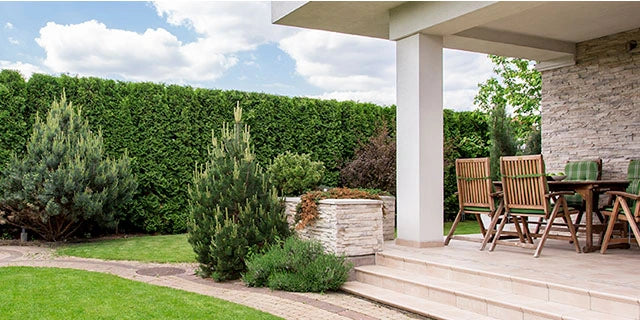
Introducing Leylandii Hedges: What You Need To Know
Hedges are an age-old landscaping solution that never goes out of style. Among the many available options, the Leylandii is among the most popular for creating privacy screens, windbreaks, and visually appealing garden boundaries.
Developed in the UK, the Leylandii is a hybrid that offers many benefits to homeowners. However, before planting your Leylandii hedge, it’s important to know how it grows and how to care for it to ensure it’s the right option for you and your garden.
This article introduces you to the Leylandii hedge, highlighting its characteristics, benefits, maintenance requirements, and potential drawbacks. If you are considering adding a hedge to your property, read on to discover what you need to know about the versatile Leylandii hedge.
What Is A Leylandii Hedge?
The Leylandii hedge, officially known as x Cuprocyparis leylandii (and also known as x Cupressocyparis Leylandii), is a fast-growing evergreen conifer hybrid widely used as a hedging plant in gardens and landscapes.
Leylandii are a cross between the Nootka cypress (Cupressus nootkatensis) and the Monterey cypress (Cupressus macrocarpa), two plants from North America that usually live hundreds of miles apart.
This hybrid was first introduced in the Leighton Hall estate in Wales during the 1800s by C J Leyland, and since then, it has become loved for its dense growth, attractive appearance, and versatility.
Characteristics Of Leylandii Hedges
Leylandii are a distinctive hedging plant with some notable characteristics.
Rapid Growth
One of the key features that make Leylandii hedges so popular is their incredibly fast growth rate. Given the right conditions, they can shoot up several feet in a year, making them an ideal choice if you’re looking to establish a dense hedge quickly.
Evergreen Foliage
Leylandii hedges retain their lush foliage throughout the year, providing a beautiful green backdrop to your garden— even during the winter months.
Height and Density
These hedges can reach impressive heights, often exceeding 20 feet if left untrimmed. Their dense growth helps create a solid screen, making them an excellent choice for privacy and windbreaks.
Adaptability
Leylandii hedges are highly adaptable and thrive in various soil types and climate conditions. However, they prefer well-draining soil and perform best in areas with plenty of sunlight.
Straightforward Maintenance
Once established, Leylandii hedges do require some maintenance. Regular pruning is essential to control their height and maintain a tidy appearance. They are easy to trim but if left untrimmed can get overgrown. Trimming once a year is usually sufficient to keep them in shape, however many people choose to trim their Leylandii hedges twice a year.
Benefits Of Leylandii Hedges
Leylandii are a popular choice for many reasons, including:
- Privacy and Security – Leylandii hedges serve as an effective privacy barrier, shielding your property from prying eyes and creating a more secure environment for you and your family.
- Noise Reduction – The dense foliage of Leylandii hedges can act as a natural sound barrier, reducing noise pollution from nearby roads or neighbours.
- Windbreaks – Due to their dense growth and height, Leylandii hedges make excellent windbreaks, protecting your garden and other plants from strong winds.
- Aesthetic Appeal – The year-round, rich green colour and fullness of Leylandii hedges adds an attractive element to any landscape, enhancing the overall look of your garden.
- Wildlife Habitat – Established Leylandii hedges provide a natural habitat for various small birds and other wildlife, boosting the biodiversity in your garden. Their dense growth makes it an ideal place for small garden birds to nest where larger predators cannot get into.
- Plant all Year Round – We sell leylandii all year round in pots and they can be planted at any time of year (although don’t forget to consider your watering plan if planting in the drier months of the year). We do not sell root balled or bare root leylandii as they do not transplant well so please be cautious about buying from less reputable nurseries who are prepared to sell you root balled or bare root leylandii.
- Reduced Pollution – Research from the Universities of Southampton and Sussex has found that Leylandii are up to 40% better at reducing air pollution than other hedges. They do this by filtering particulates, including harmful diesel fumes. This is due to the finer and more complex foliage structure. It’s been suggested that all schools in urban areas should plant Leylandii.

Taking Care of Your Leylandii
While Leylandii hedges offer numerous benefits, they require maintenance to keep them in their best shape. Here are some essential maintenance tips:
Prune Regularly
To control their height and promote healthy growth, Leylandii hedges need regular pruning, certainly once a year, but sometimes twice. We have a large leylandii hedge that is over thirty years old surrounding a large part of our nursery and we find that trimming once a year is sufficient to keep it in shape and looking good.
Prune during the active growing season, typically in late spring or early summer, to avoid excessive growth.
Check out our tips on trimming your hedge the right way.
Watering
Young Leylandii hedges need plenty of water to establish their roots. You can plant your new pot-grown Leylandii any time, but make sure you water it regularly from planting until October. Don’t overwater it though, Leylandii don’t like waterlogged soil.
Once established, Leylandii is relatively drought-tolerant but will benefit from occasional watering during dry spells.
A leaky hose is a great way to water your Leylandii without the effort. Read more about watering techniques here.
Fertilisation
Applying a balanced fertiliser can help keep your Leylandii hedges healthy and vibrant. Follow the recommended dosage and apply it during the growing season.
Pest and Disease Control
Leylandii hedges are generally resistant to pests and diseases, but it’s essential to watch for any signs of trouble. Deal with pest infestations or diseases promptly to prevent them from spreading.
Weeding and Mulching
Regular weeding around the base of the hedge helps prevent competition for nutrients. Applying a layer of mulch can also retain moisture and suppress weed growth.

What You Need To Consider Before Planting Leylandii
While Leylandii hedges have plenty of advantages, it’s important to consider all aspects before planting them:
Fast Growth
The rapid growth of Leylandii hedges can be a double-edged sword. While it allows you to establish your hedge quickly, it also means that regular pruning is necessary to prevent it from becoming unmanageably tall.
Space Requirements
Due to their potential height, Leylandii hedges need space. Planting them too close to buildings can cause issues later. Each plant should be placed at least two feet apart.
Disputes with Neighbours
Overgrown hedges can lead to disputes with neighbours, especially if they obstruct sunlight or views. It’s essential to talk to neighbours about any hedge plans to avoid conflicts.
Root System
Leylandii hedges can develop a vast root system. This may cause problems for nearby structures or drainage systems. However, if the hedge is regularly pruned and not allowed to get too large, the roots will not grow as quickly and widely thus reducing any potential impact on neighbouring structures.

Leylandii Hedges at Mathias Nurseries
Leylandii hedges offer an excellent solution if you’re seeking privacy and want to improve the appearance of your garden. With their rapid growth and dense evergreen foliage, these hedges are relatively low maintenance.
By understanding the needs of Leylandii hedges, you can make an informed decision about whether they are the right choice for your garden.
At Mathias Nurseries, our team of passionate hedging experts are always here to help advise you. We have been growing leylandii for over fifty years and it remains one of our best-selling hedges and we are now one of the largest growers of this popular conifer in the UK. Get in touch for more information on any of our hedges or products.
